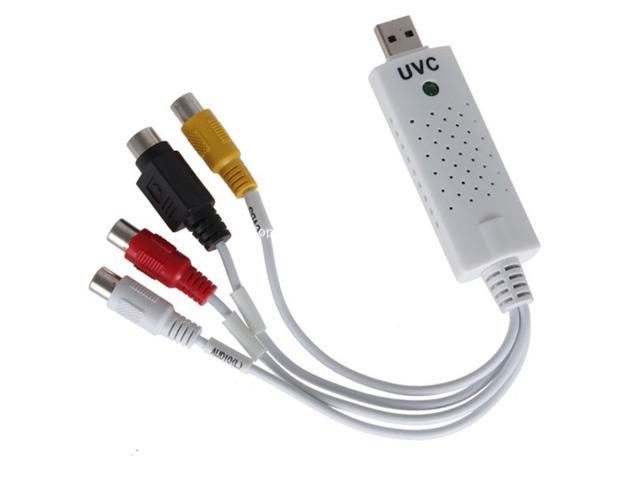Vhs To Usb Adapter For Mac
EzCAP Mac USB 2.0 TV DVD VHS Audio Capture Video Adapter Mac Video TV DVD VHS Audio Capture Adapter USB 2.0 EZCAP. The ezcap128 Mac USB. How to Connect your Computer PC Mac to your VCR. On your desktop like you would see on Internet video clips) then a Video to USB adapter will be fine.
Transfer Vhs To Mac
At Roxio we're proud of our products and we're confident that you'll be satisfied with your purchase. That's why we offer the Roxio 30-Day Money-Back Guarantee. Buy today and if you're not completely satisfied with your purchase, Roxio will refund your money based on your original method of payment - excluding any shipping costs. When you contact us about a return, your Roxio Customer Service Representative may inquire about your products and experience. Please note: Only products purchased directly from Roxio qualify for the Roxio 30-Day Money-Back Guarantee. Purchases made from a retailer or partner must be returned to where you made your purchase and are subject to the return policy of that retailer. Purchases of transactional licenses, maintenance, download insurance, Protection Plans, Training Plans, Subscriptions and Product Memberships and Priority Tickets are excluded from this guarantee.
Capture. Transfer video from your VCR to DVD in just a few clicks – the fastest way to convert your analog home video to digital.
Capture video from VCRs and directly from other analog sources including Hi8, Video8 camcorders Create. Create movies from your own video. Edit your captured movies in iMovie to add titles, transitions and other edits Share.
Post video to YouTube® or your favorite social networking sites. Convert video files to play on most popular mobile devices including iPod, iPhone and Sony PSP™. Minimum System Requirements:. Macintosh® computer with a Dual Processor PowerPC™ G5, or Intel® processor. DVD recordable drive for DVD-Video creation. Mac OS X 10.4, 10.5 or 10.6.
512MB RAM. 15GB free hard disk space recommended. Available USB 2.0 port. iMovie® HD, '08, or '09 Roxio Easy VHS to DVD for Mac Contents:. Installation CD, including. Easy VHS to DVD Capture software. Roxio Video Capture USB hardware.

USB extension cable. Video Inputs: Composite video (RCA) and S-Video (mini-DIN).
Audio Inputs: Stereo audio (RCA).

USB-C describes the shape and style of a port on your computer and the connectors that you can plug into the port. USB-C ports look like this: Several different data transfer standards, like USB 3 and Thunderbolt 3, can flow through a USB-C port and connector. You can also connect your computer's AC power adapter to a USB-C port with a. USB-C ports are reversible, so you don't have to worry about which side of the connector is up when you plug it in. These Mac computers have Thunderbolt 3 (USB-C) ports that support USB 3.1 Gen 2 and Thunderbolt 3:.
iMac Pro (2017). iMac (Retina 5K, 27-inch, 2017). iMac (Retina 4K, 21.5-inch, 2017). iMac (21.5-inch, 2017).
MacBook Pro (2016 and later) These Mac notebooks have USB-C ports that support USB 3.1 Gen 1:. MacBook (2015 and later) You can use your USB 3 devices with the above Mac models using an. Try these tips if a USB 3 device doesn't activate or appear on the USB 3 bus:. Be sure you've installed the latest software updates available for your computer. To check, choose App Store from the Apple menu and see if any updates are available.
Sometimes unplugging and plugging the device back in can resolve the issue. Try plugging the device into another USB port on the computer. Check to see if a firmware update is available for your device from the manufacturer. If the device came with an AC adapter, use it.
Restart your computer. Try a different USB 3 cable.
Try a different USB 3 hub. Some USB 3 devices can generate radio frequency interference that can cause Wi-Fi and Bluetooth devices operating in the 2.4GHz band to have issues communicating with your computer. Here are some tips to avoid this issue:. If your USB device has a cable long enough that you can move the device, place it away from your Mac—and make sure not to place it behind your Mac, or near the hinge of its display. The antennas for Wi-Fi and Bluetooth are located there, and USB 3 devices placed there might interfere with your wireless connections.
If you're using adapters or dongles on a Mac computer with Thunderbolt 3 (USB-C) ports, plug them into the front port on the left side of your Mac, or into the ports on the right side (if your computer has them). These ports are the farthest away from the antennas, making interference less likely. To avoid interference on the 2.4GHz band using Wi-Fi, try using the 5GHz band instead. You can change this on your wireless base station. Bluetooth always uses 2.4GHz, so this alternative isn't available for Bluetooth. Information about products not manufactured by Apple, or independent websites not controlled or tested by Apple, is provided without recommendation or endorsement.
Apple assumes no responsibility with regard to the selection, performance, or use of third-party websites or products. Apple makes no representations regarding third-party website accuracy or reliability. Risks are inherent in the use of the Internet. For additional information. Other company and product names may be trademarks of their respective owners.